Sho Sakaino
Imitation Learning Based on Disentangled Representation Learning of Behavioral Characteristics
Sep 05, 2025Abstract:In the field of robot learning, coordinating robot actions through language instructions is becoming increasingly feasible. However, adapting actions to human instructions remains challenging, as such instructions are often qualitative and require exploring behaviors that satisfy varying conditions. This paper proposes a motion generation model that adapts robot actions in response to modifier directives human instructions imposing behavioral conditions during task execution. The proposed method learns a mapping from modifier directives to actions by segmenting demonstrations into short sequences, assigning weakly supervised labels corresponding to specific modifier types. We evaluated our method in wiping and pick and place tasks. Results show that it can adjust motions online in response to modifier directives, unlike conventional batch-based methods that cannot adapt during execution.
Fast Bilateral Teleoperation and Imitation Learning Using Sensorless Force Control via Accurate Dynamics Model
Jul 08, 2025Abstract:In recent years, the advancement of imitation learning has led to increased interest in teleoperating low-cost manipulators to collect demonstration data. However, most existing systems rely on unilateral control, which only transmits target position values. While this approach is easy to implement and suitable for slow, non-contact tasks, it struggles with fast or contact-rich operations due to the absence of force feedback. This work demonstrates that fast teleoperation with force feedback is feasible even with force-sensorless, low-cost manipulators by leveraging 4-channel bilateral control. Based on accurately identified manipulator dynamics, our method integrates nonlinear terms compensation, velocity and external force estimation, and variable gain corresponding to inertial variation. Furthermore, using data collected by 4-channel bilateral control, we show that incorporating force information into both the input and output of learned policies improves performance in imitation learning. These results highlight the practical effectiveness of our system for high-fidelity teleoperation and data collection on affordable hardware.
Motion Generation for Food Topping Challenge 2024: Serving Salmon Roe Bowl and Picking Fried Chicken
Apr 30, 2025
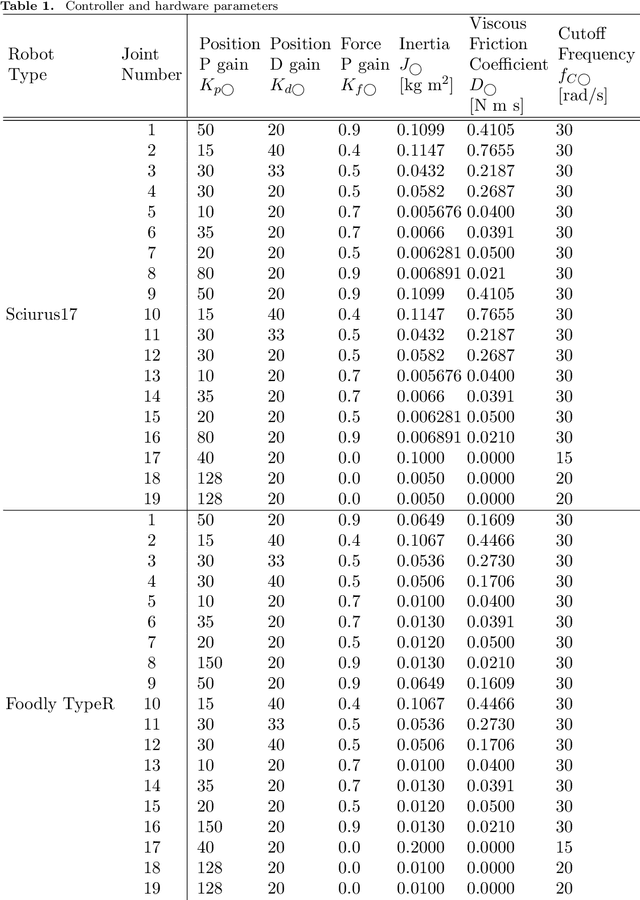
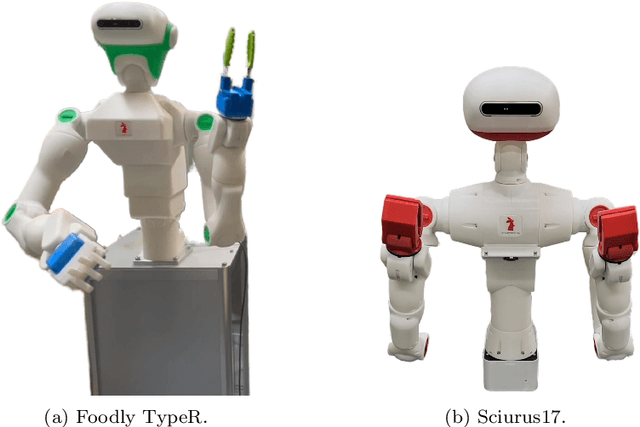
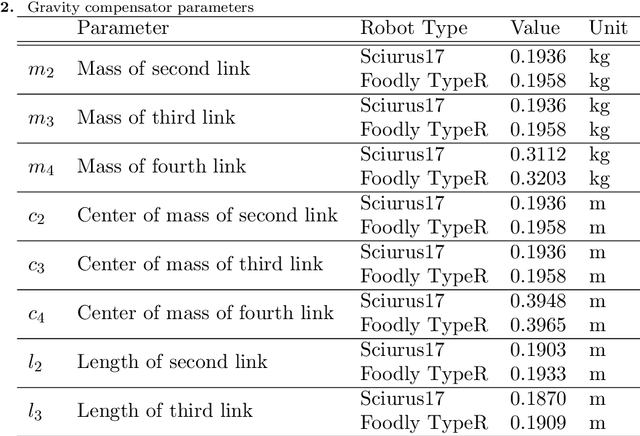
Abstract:Although robots have been introduced in many industries, food production robots are yet to be widely employed because the food industry requires not only delicate movements to handle food but also complex movements that adapt to the environment. Force control is important for handling delicate objects such as food. In addition, achieving complex movements is possible by making robot motions based on human teachings. Four-channel bilateral control is proposed, which enables the simultaneous teaching of position and force information. Moreover, methods have been developed to reproduce motions obtained through human teachings and generate adaptive motions using learning. We demonstrated the effectiveness of these methods for food handling tasks in the Food Topping Challenge at the 2024 IEEE International Conference on Robotics and Automation (ICRA 2024). For the task of serving salmon roe on rice, we achieved the best performance because of the high reproducibility and quick motion of the proposed method. Further, for the task of picking fried chicken, we successfully picked the most pieces of fried chicken among all participating teams. This paper describes the implementation and performance of these methods.
Motion ReTouch: Motion Modification Using Four-Channel Bilateral Control
Feb 28, 2025Abstract:Recent research has demonstrated the usefulness of imitation learning in autonomous robot operation. In particular, teaching using four-channel bilateral control, which can obtain position and force information, has been proven effective. However, control performance that can easily execute high-speed, complex tasks in one go has not yet been achieved. We propose a method called Motion ReTouch, which retroactively modifies motion data obtained using four-channel bilateral control. The proposed method enables modification of not only position but also force information. This was achieved by the combination of multilateral control and motion-copying system. The proposed method was verified in experiments with a real robot, and the success rate of the test tube transfer task was improved, demonstrating the possibility of modification force information.
Variable-Speed Teaching-Playback as Real-World Data Augmentation for Imitation Learning
Dec 04, 2024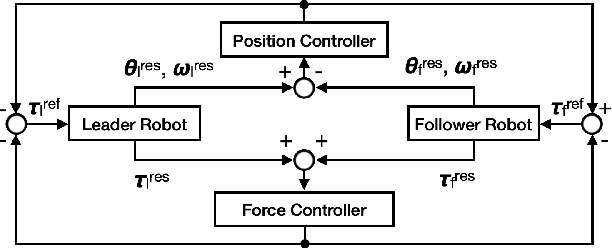

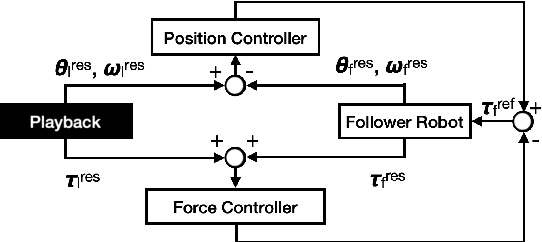

Abstract:Because imitation learning relies on human demonstrations in hard-to-simulate settings, the inclusion of force control in this method has resulted in a shortage of training data, even with a simple change in speed. Although the field of data augmentation has addressed the lack of data, conventional methods of data augmentation for robot manipulation are limited to simulation-based methods or downsampling for position control. This paper proposes a novel method of data augmentation that is applicable to force control and preserves the advantages of real-world datasets. We applied teaching-playback at variable speeds as real-world data augmentation to increase both the quantity and quality of environmental reactions at variable speeds. An experiment was conducted on bilateral control-based imitation learning using a method of imitation learning equipped with position-force control. We evaluated the effect of real-world data augmentation on two tasks, pick-and-place and wiping, at variable speeds, each from two human demonstrations at fixed speed. The results showed a maximum 55% increase in success rate from a simple change in speed of real-world reactions and improved accuracy along the duration/frequency command by gathering environmental reactions at variable speeds.
Error-Feedback Model for Output Correction in Bilateral Control-Based Imitation Learning
Nov 19, 2024Abstract:In recent years, imitation learning using neural networks has enabled robots to perform flexible tasks. However, since neural networks operate in a feedforward structure, they do not possess a mechanism to compensate for output errors. To address this limitation, we developed a feedback mechanism to correct these errors. By employing a hierarchical structure for neural networks comprising lower and upper layers, the lower layer was controlled to follow the upper layer. Additionally, using a multi-layer perceptron in the lower layer, which lacks an internal state, enhanced the error feedback. In the character-writing task, this model demonstrated improved accuracy in writing previously untrained characters. In the character-writing task, this model demonstrated improved accuracy in writing previously untrained characters. Through autonomous control with error feedback, we confirmed that the lower layer could effectively track the output of the upper layer. This study represents a promising step toward integrating neural networks with control theories.
Variable-Frequency Imitation Learning for Variable-Speed Motion
Nov 19, 2024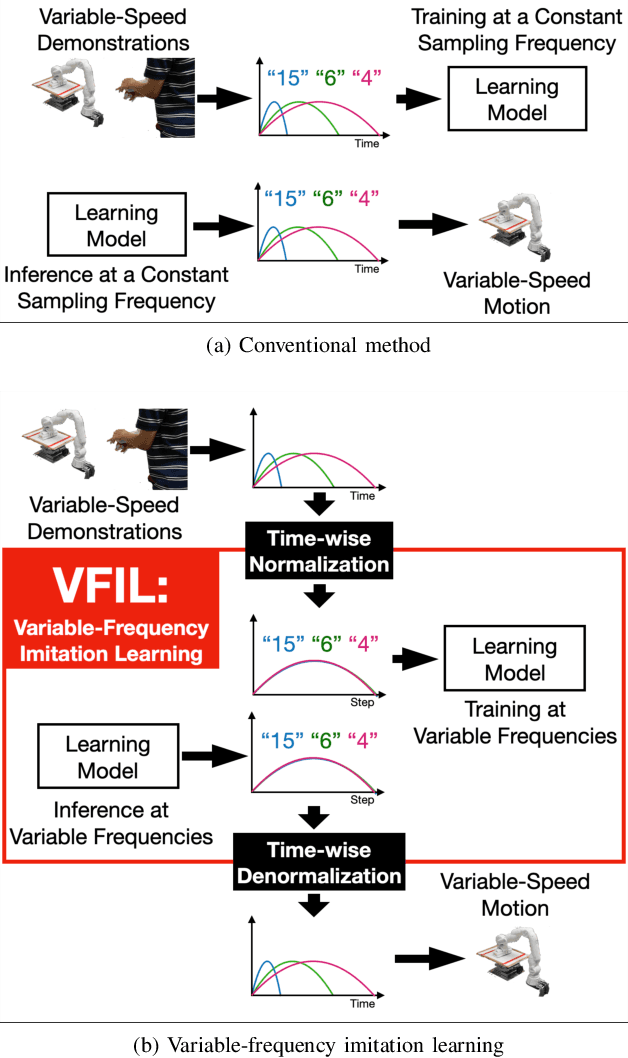
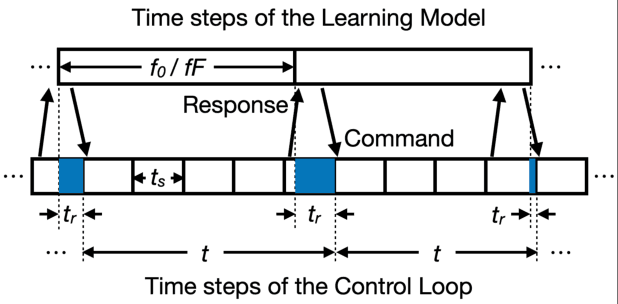
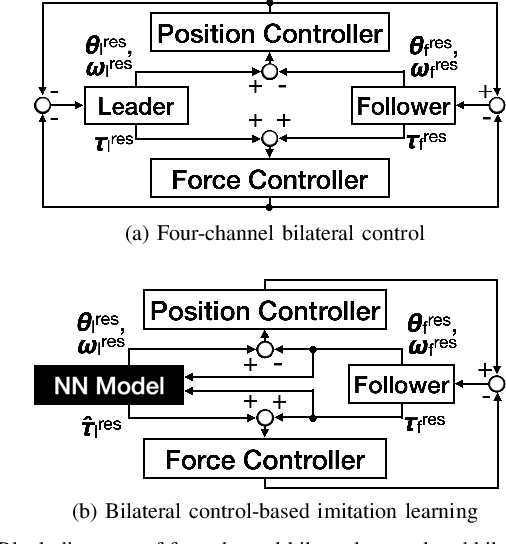
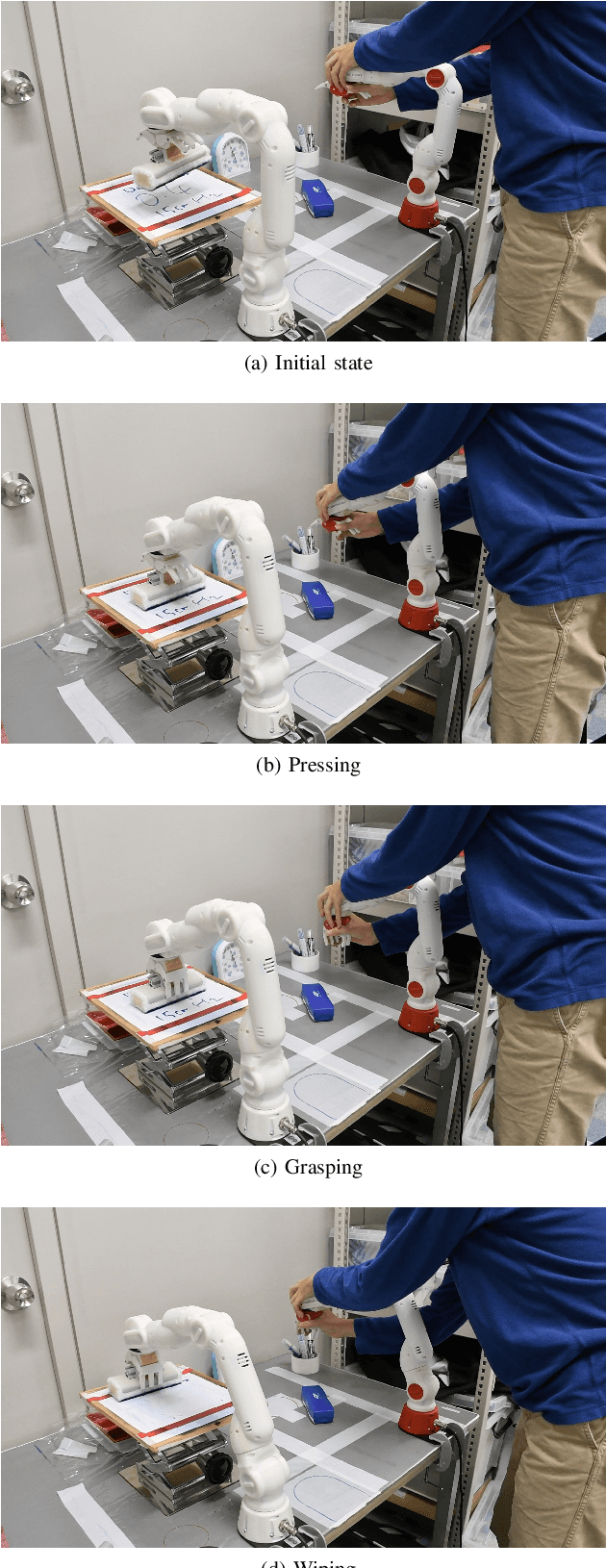
Abstract:Conventional methods of imitation learning for variable-speed motion have difficulty extrapolating speeds because they rely on learning models running at a constant sampling frequency. This study proposes variable-frequency imitation learning (VFIL), a novel method for imitation learning with learning models trained to run at variable sampling frequencies along with the desired speeds of motion. The experimental results showed that the proposed method improved the velocity-wise accuracy along both the interpolated and extrapolated frequency labels, in addition to a 12.5 % increase in the overall success rate.
Loss Function Considering Dead Zone for Neural Networks
Feb 01, 2024



Abstract:It is important to reveal the inverse dynamics of manipulators to improve control performance of model-based control. Neural networks (NNs) are promising techniques to represent complicated inverse dynamics while they require a large amount of motion data. However, motion data in dead zones of actuators is not suitable for training models decreasing the number of useful training data. In this study, based on the fact that the manipulator joint does not work irrespective of input torque in dead zones, we propose a new loss function that considers only errors of joints not in dead zones. The proposed method enables to increase in the amount of motion data available for training and the accuracy of the inverse dynamics computation. Experiments on actual equipment using a three-degree-of-freedom (DOF) manipulator showed higher accuracy than conventional methods. We also confirmed and discussed the behavior of the model of the proposed method in dead zones.
Imitation Learning Inputting Image Feature to Each Layer of Neural Network
Jan 19, 2024
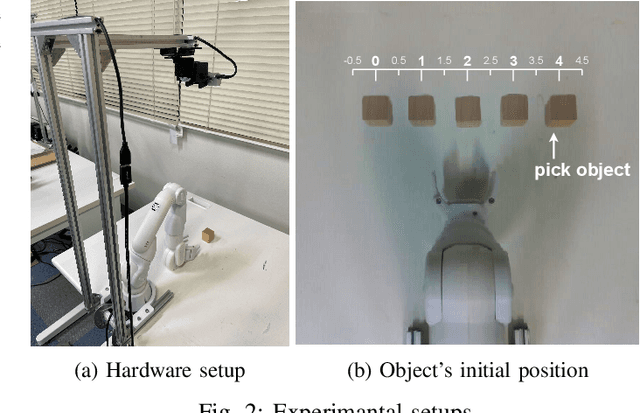
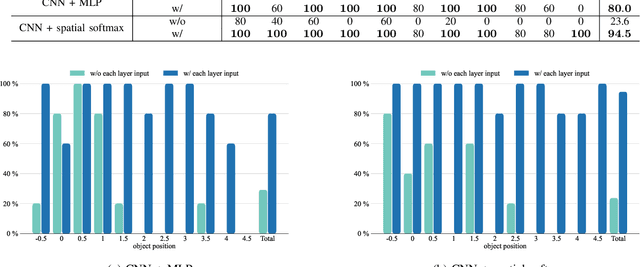
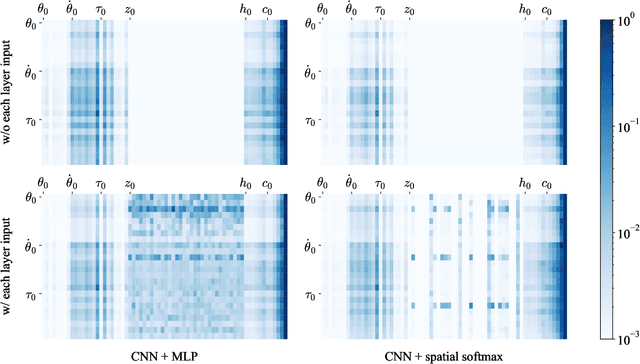
Abstract:Imitation learning enables robots to learn and replicate human behavior from training data. Recent advances in machine learning enable end-to-end learning approaches that directly process high-dimensional observation data, such as images. However, these approaches face a critical challenge when processing data from multiple modalities, inadvertently ignoring data with a lower correlation to the desired output, especially when using short sampling periods. This paper presents a useful method to address this challenge, which amplifies the influence of data with a relatively low correlation to the output by inputting the data into each neural network layer. The proposed approach effectively incorporates diverse data sources into the learning process. Through experiments using a simple pick-and-place operation with raw images and joint information as input, significant improvements in success rates are demonstrated even when dealing with data from short sampling periods.
Soft and Rigid Object Grasping With Cross-Structure Hand Using Bilateral Control-Based Imitation Learning
Nov 16, 2023



Abstract:Object grasping is an important ability required for various robot tasks. In particular, tasks that require precise force adjustments during operation, such as grasping an unknown object or using a grasped tool, are difficult for humans to program in advance. Recently, AI-based algorithms that can imitate human force skills have been actively explored as a solution. In particular, bilateral control-based imitation learning achieves human-level motion speeds with environmental adaptability, only requiring human demonstration and without programming. However, owing to hardware limitations, its grasping performance remains limited, and tasks that involves grasping various objects are yet to be achieved. Here, we developed a cross-structure hand to grasp various objects. We experimentally demonstrated that the integration of bilateral control-based imitation learning and the cross-structure hand is effective for grasping various objects and harnessing tools.
 Add to Chrome
Add to Chrome Add to Firefox
Add to Firefox Add to Edge
Add to Edge